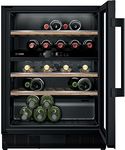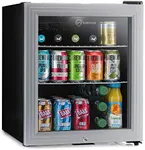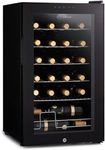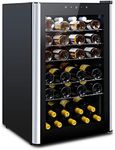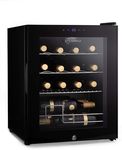Buying Guide for the Best Wine Coolers
Choosing the right wine cooler involves understanding your wine storage needs and the features that will best preserve your collection. Wine coolers are designed to maintain the ideal temperature and humidity for wine storage, ensuring that your wine ages properly and tastes its best when you decide to open a bottle. When selecting a wine cooler, consider the size of your collection, the types of wine you store, and where you plan to place the cooler. Understanding the key specifications will help you make an informed decision that suits your lifestyle and wine preferences.CapacityCapacity refers to the number of wine bottles a cooler can hold. This is important because it determines how much wine you can store at one time. Wine coolers come in various sizes, from small units that hold a dozen bottles to large ones that can store over a hundred. If you are a casual wine drinker, a smaller capacity might suffice. However, if you are a collector or entertain frequently, you might need a larger capacity. Consider your current collection size and whether you plan to expand it in the future when choosing the right capacity.
Temperature ZonesTemperature zones in a wine cooler refer to the different areas within the cooler that can be set to different temperatures. This is crucial for storing different types of wine, as red, white, and sparkling wines have different optimal storage temperatures. Single-zone coolers maintain one consistent temperature throughout, which is suitable if you primarily store one type of wine. Dual-zone or multi-zone coolers allow for different temperature settings in separate compartments, ideal for those who store a variety of wines. Choose based on the diversity of your wine collection.
Cooling SystemThe cooling system in a wine cooler can be either compressor-based or thermoelectric. Compressor coolers are powerful and can maintain consistent temperatures even in warmer environments, making them suitable for larger collections or placement in less controlled environments like garages. Thermoelectric coolers are quieter and more energy-efficient but are better suited for smaller collections and need to be placed in a cooler room. Consider where you will place the cooler and the size of your collection when deciding on the cooling system.
Humidity ControlHumidity control is a feature that helps maintain the right level of moisture inside the wine cooler. Proper humidity is important to prevent corks from drying out, which can spoil the wine. Some wine coolers come with built-in humidity control systems, while others may require you to add a water tray. If you live in a dry climate or plan to store wine for long periods, a cooler with humidity control is beneficial. Evaluate your storage conditions and duration to determine if this feature is necessary for you.
Size and PlacementThe size and placement of a wine cooler are important considerations for ensuring it fits well in your space and functions efficiently. Wine coolers come in various sizes, from compact countertop models to larger freestanding units. Measure the space where you plan to place the cooler and ensure there is adequate ventilation around it. Built-in models are designed to fit seamlessly into cabinetry, while freestanding models require more space. Consider your available space and how you want the cooler to integrate with your home decor.
Noise LevelNoise level refers to how much sound the wine cooler makes while operating. This is important if you plan to place the cooler in a living area or near bedrooms. Compressor-based coolers tend to be noisier than thermoelectric ones, which are quieter. If noise is a concern, especially in quiet environments, opt for a thermoelectric model. Consider where the cooler will be located and how sensitive you are to noise when making your choice.
